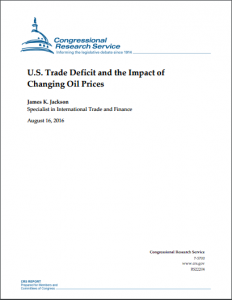Full Title: U.S. Trade Deficit and the Impact of Changing Oil Prices
Author(s): James K. Jackson
Publisher(s): Congressional Research Service
Publication Date: August 1, 2016
Full Text: Download Resource
Description (excerpt):
Imported petroleum prices fell from an average price of $91.23 per barrel of crude oil in 2014 to an average price of $47.28 per barrel in 2015, or a drop of 48%. This represents the lowest price per barrel of crude oil since early 2009, when the global economy was slowing sharply. Through June 2016, the price per barrel of oil slipped below $30 at times. Similarly, the volume of crude oil imports for 2015 fell by 1.4% from the amount imported in 2014. The sharp decline in the average price of a barrel of crude oil combined with the drop in the amount, or the volume, of oil imports in 2015 compared with 2014 not only resulted in a drop in the overall value of imported crude oil, but also a sharp drop in the share of the total U.S. merchandise trade deficit that is associated with the trade deficit in energy imports. Although oil import volumes increased in the January through June period in 2016 compared with the similar period in 2015, the overall value of oil imports dropped by one-third due to lower per barrel import prices.
In general, market demand for oil remains highly resistant to changes in oil prices and reflects the unique nature of the demand for and the supply of energy-related imports. Turmoil in the Middle East is an important factor that continues to create uncertainty in global petroleum markets and was one of the most important factors in causing petroleum prices to rise sharply in early 2011 and in 2012. A slowdown in the rate of growth in the Chinese economy, combined with a collapse in raw material prices, a slowdown in the rate of economic growth among commodity-exporting developing economies, and continued slow rates of growth among many of the major developed economies, all have held down demand for energy products, despite the sharp drop in prices that typically would stimulate demand. Fluctuations in U.S. energy production, uncertainty concerning oil production decisions by various members of the Organization of the Petroleum Exporting Countries (OPEC), and the potential impact of new Iranian supplies of oil also have worked to push up the global market price of oil. Oil futures markets in August 2016 indicate that oil traders expect crude oil prices to trend in the range of $47-$49 per barrel by the end of the year, substantially higher than early 2016 futures prices. This report provides an estimate of the initial impact of the changing oil prices on the nation’s merchandise trade balance.
